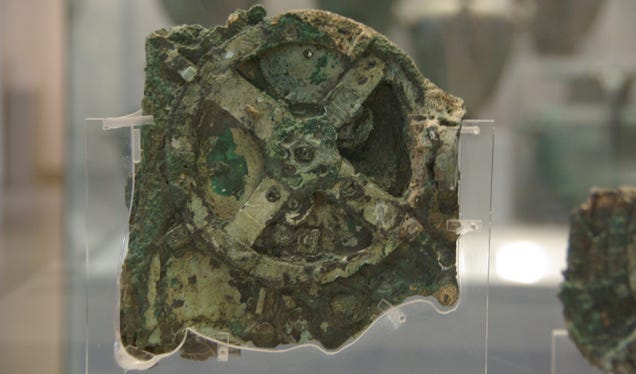New analysis of the Antikythera Mechanism suggests the astronomical device is older than archaeologists assumed. Archaeologists and historians aren't entirely sure when the machine was constructed, or by whom, though its design may have been influenced by the scientific teachings of Archimedes, Hipparchus, or Posidonius. But as the New York Times reports, a new analysis of the dial used to predict eclipses (which is set on the back of the device) is offering some important new clues:
"Christián C. Carman, a science historian at the National University of Quilmes in Argentina, and James Evans, a physicist at the University of Puget Sound in Washington, suggest that the calendar of the mysterious device began in 205 B.C., just seven years after Archimedes died.
"Christián C. Carman, a science historian at the National University of Quilmes in Argentina, and James Evans, a physicist at the University of Puget Sound in Washington, suggest that the calendar of the mysterious device began in 205 B.C., just seven years after Archimedes died.
The mechanism was most likely housed in a wooden box and operated by a hand crank. The device itself bears inscriptions on the front and back. In the 1970s, the engravings were estimated to date from 87 B.C. But more recently, scientists examining the forms of the Greek letters in the inscriptions dated the mechanism to 150 to 100 B.C.
Writing this month in the journal Archive for History of Exact Sciences, Dr. Carman and Dr. Evans took a different tack. Starting with the ways the device's eclipse patterns fit Babylonian eclipse records, the two scientists used a process of elimination to reach a conclusion that the "epoch date," or starting point, of the Antikythera Mechanism's calendar was 50 years to a century earlier than had been generally believed.
The finding supports the idea, scientists said, that the mechanism's eclipse prediction strategy was not based on Greek trigonometry, which did not exist at the time, but on Babylonian arithmetical methods borrowed by the Greeks."
The Antikythera mechanism is an ancient analog computer designed to predict
astronomical positions and eclipses. The computer's construction has been
attributed to the Hellenes and was originally dated to the early 1st century BC.
Technological artefacts approaching its complexity and workmanship did not
appear again until the 14th century, when mechanical astronomical clocks began
to be built in Western Europe.
The mechanism was housed in a wooden box and is made up of bronze gears (that we know of). The mechanism's remains were found as eighty-two separate fragments of which only seven contain any gears or significant inscriptions. Today, the fragments of the Antikythera mechanism are kept at the National Archaeological Museum of Athens.
The mechanism was housed in a wooden box and is made up of bronze gears (that we know of). The mechanism's remains were found as eighty-two separate fragments of which only seven contain any gears or significant inscriptions. Today, the fragments of the Antikythera mechanism are kept at the National Archaeological Museum of Athens.


1 comment:
Loved this information. http://www.youtube.com/watch?v=RfjDAWJAAlo
Post a Comment